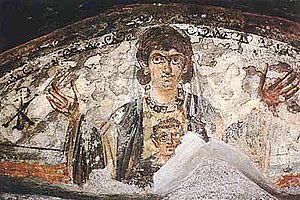
Back المسيحية في العصور القديمة المتأخرة Arabic Παλαιοχριστιανική περίοδος Greek Cristianismo en la antigüedad tardía Spanish Kekristenan pada Abad Kuno Akhir ID 古代末期のキリスト教 Japanese Laat-antiek christendom Dutch Chrześcijaństwo w późnej starożytności Polish

Christianity in late antiquity traces Christianity during the Christian Roman Empire — the period from the rise of Christianity under Emperor Constantine (c. 313), until the fall of the Western Roman Empire (c. 476). The end-date of this period varies because the transition to the sub-Roman period occurred gradually and at different times in different areas. One may generally date late ancient Christianity as lasting to the late 6th century and the re-conquests under Justinian (reigned 527–565) of the Byzantine Empire, though a more traditional end-date is 476, the year in which Odoacer deposed Romulus Augustus, traditionally considered the last western emperor.
Christianity began to spread initially from Roman Judaea without state support or endorsement. It became the state religion of Armenia in either 301 or 314, of Ethiopia in 325, and of Georgia in 337. With the Edict of Thessalonica it became the state religion of the Roman Empire in 380.
© MMXXIII Rich X Search. We shall prevail. All rights reserved. Rich X Search